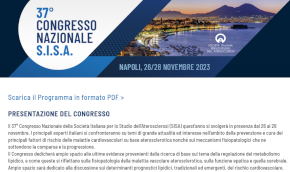 Rivista in lingua italiana
Rivista in lingua italiana
riservata ai Soci SISA
Ultimo numero:
Anno 14 • N.4/2023
Abstract
Relations of lipid concentrations to heart failure incidence: the Framingham Heart Study
Velagaleti RS, Massaro J, Vasan RS, Robins SJ, Kannel WB, Levy D.
Circulation 2009;120:2345-51
BACKGROUND: The relations of lipid concentrations to heart failure (HF) risk have not been elucidated comprehensively.
METHODS AND RESULTS: In 6860 Framingham Heart Study participants (mean age, 44 years; 54% women) free of baseline coronary heart disease, we related high-density lipoprotein cholesterol (HDL-C) and non-HDL-C to HF incidence during long-term follow-up, adjusting for clinical covariates and myocardial infarction at baseline and updating these at follow-up examinations. We evaluated dyslipidemia-specific population burden of HF by calculating population attributable risks. During follow-up (mean of 26 years), 680 participants (49% women) developed HF. Unadjusted HF incidence in the low (<160 mg/dL) versus high (> or =190 mg/dL) non-HDL-C groups was 7.9% and 13.8%, respectively, whereas incidence in the high (> or =55 [men], > or =65 [women] mg/dL) versus low (<40 [men], <50 [women] mg/dL) HDL-C groups was 6.1% and 12.8%, respectively. In multivariable models, baseline non-HDL-C and HDL-C, modeled as continuous measures, carried HF hazards (confidence intervals) of 1.19 (1.11 to 1.27) and 0.82 (0.75 to 0.90), respectively, per SD increment. In models updating lipid concentrations every 8 years, the corresponding hazards (confidence intervals) were 1.23 (1.16 to 1.31) and 0.77 (0.70 to 0.85). Participants with high baseline non-HDL-C and those with low HDL-C experienced a 29% and 40% higher HF risk, respectively, compared with those in the desirable categories; the population attributable risks for high non-HDL-C and low HDL-C were 7.5% and 15%, respectively. Hazards associated with non-HDL-C and HDL-C remained statistically significant after additional adjustment for interim myocardial infarction.
CONCLUSIONS: Dyslipidemia carries HF risk independent of its association with myocardial infarction, suggesting that lipid modification may be a means for reducing HF risk.

Area Soci
Eventi



 SISA LIPID ACADEMY - Corso avanzato di lipidologia clinica
SISA LIPID ACADEMY - Corso avanzato di lipidologia clinicaModena, 22-23 Giugno 2023
[continua a leggere]Giornale Italiano Arteriosclerosi
HoFH today
 Rivista Italiana della
Rivista Italiana della
Ipercolesterolemia
Familiare Omozigote
Anno 5 • N.1/2023
Rivista NMCD
Diateca
[continua a leggere]
[continua a leggere]
Newsletter
il vostro indirizzo di posta elettronica
Progetto LIPIGEN

Nuovo sito dedicato al Progetto LIPIGEN
Progetto LIPIGEN - Vecchio portale
E' necessario essere loggati come utente
Lipigen per poter accedere alla pagina
PROject Statin Intolerance SISA
PROSISA – PROject Statin Intolerance SISA
E' necessario essere loggati come utente
PROSISA per poter accedere alla pagina
GILA - Lipoprotein Aferesi
Gruppo Interdisciplinare Lipoprotein Aferesi
(Accesso Gruppo GILA-Lipoprotein Aferesi)
E' necessario essere loggati come utente del Gruppo GILA per poter accedere
Gruppo Interdisciplinare Lipoprotein Aferesi
(Documentazione ad accesso libero)
Pagina informativa per medici e pazienti








